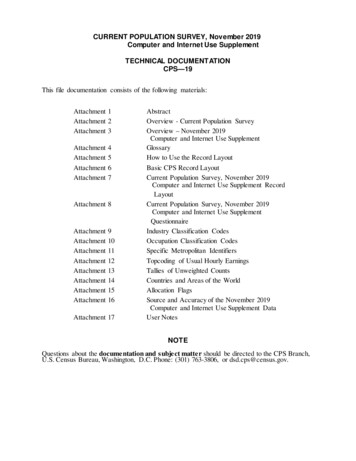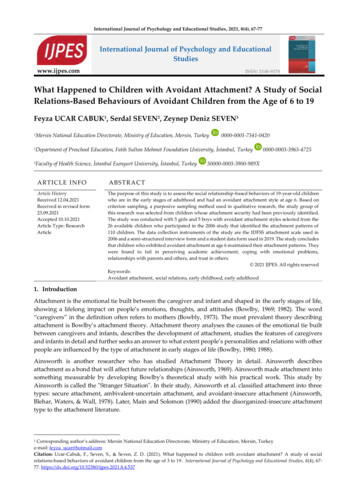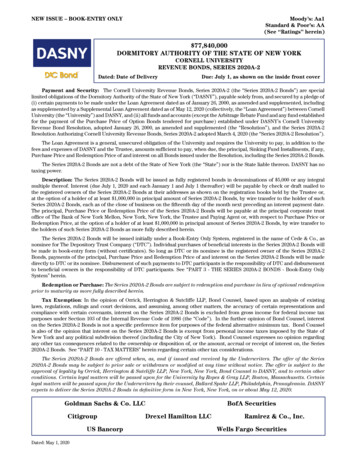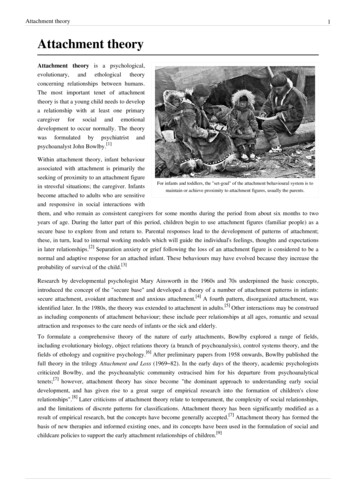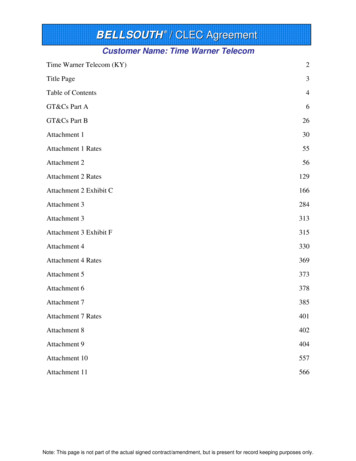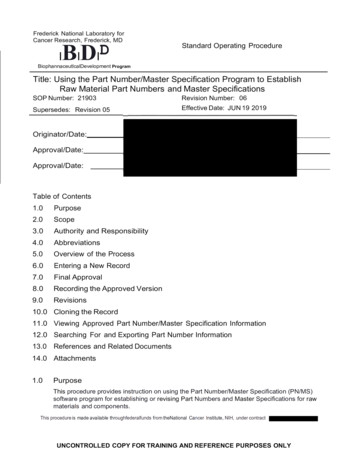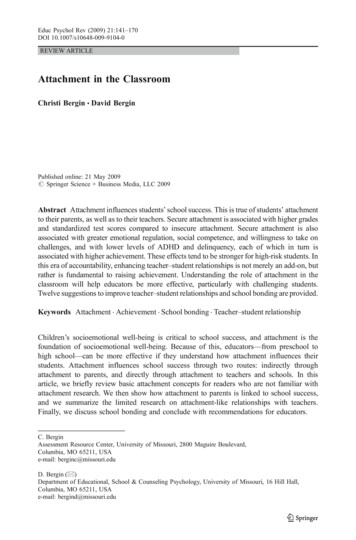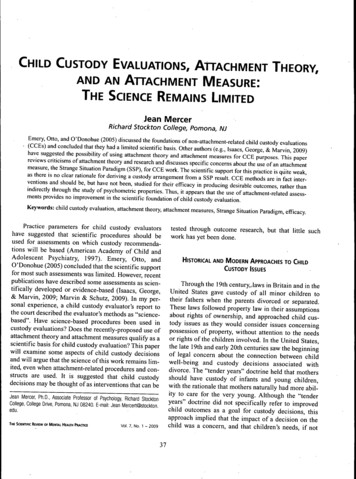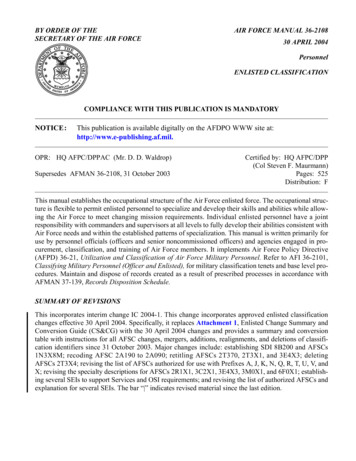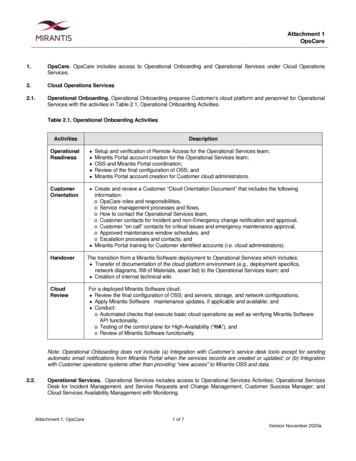
Transcription
Attachment 1OpsCare1.OpsCare. OpsCare includes access to Operational Onboarding and Operational Services under Cloud OperationsServices.2.Cloud Operations Services2.1.Operational Onboarding. Operational Onboarding prepares Customer’s cloud platform and personnel for OperationalServices with the activities in Table 2.1, Operational Onboarding Activities.Table 2.1, Operational Onboarding s CustomerOrientation Create and review a Customer “Cloud Orientation Document” that includes the followingSetup and verification of Remote Access for the Operational Services team;Mirantis Portal account creation for the Operational Services team;OSS and Mirantis Portal coordination;Review of the final configuration of OSS; andMirantis Portal account creation for Customer cloud administrators.information:o OpsCare roles and responsibilities,o Service management processes and flows,o How to contact the Operational Services team,o Customer contacts for Incident and non-Emergency change notification and approval,o Customer “on call” contacts for critical issues and emergency maintenance approval,o Approved maintenance window schedules, ando Escalation processes and contacts; and Mirantis Portal training for Customer identified accounts (i.e. cloud administrators).HandoverThe transition from a Mirantis Software deployment to Operational Services which includes: Transfer of documentation of the cloud platform environment (e.g., deployment specifics,network diagrams, Bill of Materials, asset list) to the Operational Services team; and Creation of internal technical wiki.CloudReviewFor a deployed Mirantis Software cloud: Review the final configuration of OSS; and servers, storage, and network configurations; Apply Mirantis Software maintenance updates, if applicable and available; and Conduct:o Automated checks that execute basic cloud operations as well as verifying Mirantis SoftwareAPI functionality,o Testing of the control plane for High-Availability (“HA”), ando Review of Mirantis Software functionality.Note: Operational Onboarding does not include (a) Integration with Customer’s service desk tools except for sendingautomatic email notifications from Mirantis Portal when the services records are created or updated; or (b) Integrationwith Customer operations systems other than providing “view access” to Mirantis OSS and data.2.2.Operational Services. Operational Services includes access to Operational Services Activities; Operational ServicesDesk for Incident Management, and Service Requests and Change Management; Customer Success Manager; andCloud Services Availability Management with Monitoring.Attachment 1, OpsCare1 of 7Version November 2020a
2.2.1.Operational Services Activities. Operational Services Activities are described in Table 2.2.1, Operational ServicesActivities.Table 2.2.1, Operational Services ActivitiesActivitiesOperational Activities DescriptionMirantis SoftwareMonitoringMirantis Software logging, monitoring and alerting for Mirantis Software cloud services whichis dependent on cloud type (i.e., Mirantis Cloud Native Platform Software or MirantisOpenStack (e.g., Mirantis Container Runtime, Mirantis Cluster Engine, and Mirantis SecureRegistry or Nova, Keystone, Cinder, Glance, Horizon, and Heat) API’s; and, depending oncomponents (devices Central Processing Unit (“CPU”), disk, memory, I/O and processes,etc.) using Mirantis OSS toolchain. Includes Mirantis Software anomaly and fault detection,Mirantis Software services events and logs correlation, and time series metrics collection andaggregation.Environmentevents, Incident &problemmanagementManage Mirantis Software environment orchestration events, alerts, and tickets in MirantisPortal using Incident management and problem management procedures for MirantisSoftware cloud services which is dependent on cloud type, i.e., Mirantis Cloud NativePlatform Software or Mirantis OpenStack (e.g., Mirantis Container Runtime, Mirantis ClusterEngine, and Mirantis Secure Registry or Nova, Keystone, Cinder, Glance, Horizon, andHeat).SoftwareConfiguration &DeploymentManagementManage Mirantis Software maintenance updates planning, tests and execution, operatingsystem patches, and Mirantis Software configuration changes described in Section 2.2.2.2Mirantis SoftwareUpgradeUpgrade planning and reviews to identify updates, dependent on cloud type (i.e., MirantisCloud Native Platform Software or DriveTrain-based) including at least 1 upgrade to theMirantis Cloud Native Platform Software, OpenStack, or Kubernetes software once per 12month Subscription Services term. Note: Mirantis Software Upgrade(s) are non-disruptive butmay require multiple maintenance windows.Monthly Reporting2.2.2.Overview of the Operational Services Activities including information such as: Cloud services availability metrics:o Control Plane API Availability, ando Compute & Storage Resources usage. Service desk ticket records and trends:o Operational Service Desk records creation, closure, response, and resolution time, ando Change requests and maintenance windows.Operational Services Desk. The Operational Services Desk is made available using Mirantis Portal using InformationTechnology Infrastructure Library (“ITIL”) based practices to provide access to the following:2.2.2.1. Incident Management. Incident management assists Customer with recovery from, or prevention of, an interruption inservice within the scope of OpsCare (an “Incident”). Incident management severity Level and Response for OpsCare isas shown in Exhibit A, Mirantis Subscription Services. Customer may report Incident(s) using the submission of a supportticket process for Mirantis Subscription Services through the Mirantis Portal. Within 5 business days of a Severity 1Incident resolution affecting services in OpsCare, Mirantis will provide Customer with a root cause analysis (“RCA”) reportwith status of triage including a probable or determined root cause. This report may include any remaining steps to confirmthe root cause and, when appropriate, recommendations for future Incident prevention. Customer shall be responsiblefor obtaining, maintaining, and complying with the terms for all such maintenance agreements with such 3rd party supportprovider(s) and ensuring that such maintenance agreements allow Mirantis to escalate issues to relevant 3rd party supportprovider(s) on behalf of the Customer.2.2.2.2. Service Requests and Change Managementa.Service Requests. A service request is a support request that may require changes to Customer’s system(s) orAttachment 1, OpsCare2 of 7Version November 2020a
Mirantis Software configuration. Request to modify or change Mirantis Software code relating to feature enhancementor new functionality are not included in the scope of the Operational Services.b.Change Management. Mirantis provides the controlled identification and implementation of changes with theCustomer’s Mirantis Software environment within the scope of Operational Services as described directly below(each a “Change” or together, “Changes”). Changes are further defined as follows:ChangesDescriptionStandard ChangePre-authorized changes that are low risk, relatively common, and involvechanges to OSS tooling monitoring, and alerting.Normal ChangePlanned changes to infrastructure supporting the service (disruptive or nondisruptive). For example, Mirantis Software maintenance updates, cloudplatform patches, and host Operating System patches. A Normal Changefollows the defined steps of this standard Change Management process.Emergency ChangeChanges that must be introduced as soon as possible outside of the approvedmaintenance schedule. This type of change may be necessary to reduce risk ofpotential service interruption or to address a Severity 1 Incident.Unless a Change is identified by Mirantis as an Emergency Change, all changes will be available during the approvedmaintenance windows, which are defined during Operational Onboarding and documented in the Cloud OrientationDocument.For planned and Emergency Changes, Mirantis will provide Customer a maintenance plan that may include, forexample, impact, execution steps, test procedures, a rollback plan (if applicable), and an estimate of the resources(e.g. time, effort) likely needed to apply the Change. Change Management status is available to Customer throughthe Mirantis Portal. For Changes that may be disruptive to Mirantis Software environment, Customer is responsiblefor providing written (i) approval for Changes prior to making the Change; and (ii) validation of the Change afterimplemented, using Mirantis Portal. Mirantis Software Upgrades and updates to the Customer’s Mirantis Softwareenvironment are available using the Change Management process. Mirantis Software Upgrades and updates arelimited to the Mirantis Software under OpsCare. Mirantis Software Upgrade(s) may require longer maintenancewindow execution and Customer resources for upgrade planning, assessment, testing, and validation. MirantisSoftware Upgrade(s) do not include the maintenance of software of any custom pipelines, formulas, or any customextension of Mirantis Software that were developed as part of separate services engagements.2.2.3.Customer Success Manager. A Customer Success Manager will become familiar with the Customer’s technicalenvironment, business objectives, Mirantis Software roadmap, coordinate support services, and the following:a.b.c.d.e.f.g.Assist with the development and maintenance of Customer plans that outline the critical factors, metrics, potentialissues, and action plans;Coordinate monthly operations reviews;Establish meetings with Mirantis product team personnel to review status and action plans for open cases, on an ifand when available basis;Be the Customer's single point of contact for support services, to help drive critical issue management, escalationand resolution;Coordinate access to the community and Mirantis product team. Communicate Customer’s position(s) for inclusionin future Kubernetes and/or OpenStack software/product releases, if relevant and as necessary;Provide guidance in Mirantis Software life cycle planning and coordinate impact analysis and approval of changerequests; andInform Customer on key new features/fixes and assist with planning for new releases of Mirantis Software.The Customer Success Manager is available during Business Hours (9:00 a.m. through 5:00 p.m. Monday-Friday) in thetime zone in which the control plane is installed or the primary location of usage if installed in multiple time zones.2.2.4.Cloud Services Availability ManagementAttachment 1, OpsCare3 of 7Version November 2020a
2.2.4.1. Monitoring. Operational Services include cloud services availability monitoring and alerting services 24 hours a dayduring the OpsCare Subscription Services term using the Mirantis OSS toolchain. Mirantis OSS operations framework isused as a flexible Service Level Objectives (“SLO”) composition tool for Mirantis Software. SLOs are composed fromQuality of Service (“QoS”) measurements that are combined to produce a global (or macro) SLO achievement value. Forexample, the availability SLO for the control plane depends on the SLO of multiple components, resources, and services,each of which having their own QoS availability measurement. The Mirantis OSS toolchain combines and correlates QoSmeasurements of different components into one macro SLO achievement value. QoS availability measurements arereported according to five different states:QoS StatesDescriptionDownOne or several primary functions of a service have failed. Meaning, theOpenStack and/or Mirantis Cloud Native Platform and/or Kubernetes service isno longer accessible.CriticalOne or several primary functions of an OpenStack and/or Mirantis Cloud NativePlatform and/or Kubernetes service are in critical state, meaning that the QoScan be severely degraded. It can also be indicative of a critical condition thatmust be immediately addressed.WarningOne or several primary functions of an OpenStack and/or Mirantis Cloud NativePlatform and/or Kubernetes service are slightly degraded meaning that the QoScan be slightly degraded. It can also be indicative of an anomaly that should beaddressed.UnknownThere is not enough data to infer an opinion about the availability state of anOpenStack and/or Mirantis Cloud Native Platform and/or Kubernetes service.OkayNone of the above.Using the global state evaluation aggregation and correlation mechanisms of the Mirantis OSS, QoS measurements arecombined to produce macro availability SLO achievement value for the control plane. The control plane SLO achievementvalue is “Down” when OpenStack and/or Mirantis Cloud Native Platform and/or Kubernetes service is reported as “Down”or “Unknown”; or “Up” when OpenStack and/or Mirantis Cloud Native Platform and/or Kubernetes service is reported as“Critical”, “Warning”, or “Okay”. Mirantis records and data are the basis for all availability calculations and determinations.Mirantis will generate an event ticket for each availability alert issued to Mirantis’ Operational Services support engineers.3.OpsCare Service Level Assurance3.1.Control Plane API Monthly Availability3.1.1.Control Plane APIs. Mirantis provides a service level assurance for the OpenStack and/or Mirantis Cloud Native Platformand/or Kubernetes Application Programming Interfaces (“API” or “APIs”) in the Mirantis Software control plane (“ControlPlane API”) under Operational Services. If the Control Plane API(s) are not available as shown in Table 3.1.2, MonthlyAvailability, Control Plane API service level credits (“Credits”) are available to Customer as provided in Section 3.3.1.2.Monthly Availability. Mirantis will measure the Monthly Availability of the Control Plane APIs using the Mirantis OSSinstalled and configured as part of OpsCare Subscription Services. Monthly Availability of the Control Plane API iscalculated as Downtime during each month, as follows (represented as a percentage): 1- (Downtime (minutes) / month(minutes)). Monthly Availability of the Control Plane API is measured separately for all Control Plane APIs. MonthlyAvailability measured for Multi-Region requires all physically distinct fault domains with no single point of failure or sharedresource between all cloud regions to have Downtime. “Downtime” means a period of five (5) consecutive minutes duringwhich (i) Compute (Nova), Networking (Neutron), Image Service (Glance), Identity (Keystone), or Block Storage (Cinder)core OpenStack service APIs for the OpenStack API(s); and/or (ii) Mirantis Cloud Native Platform components and/or (iii)Kubernetes API (provided by kube-apiserver) for the Kubernetes API(s), is unreachable or requests are timing out.Downtime does not include periods during which the Control Plane API endpoint is unreachable or requests are timingout that are intermittent (e.g. less than 5 minutes); the result of Mirantis performing maintenance on the services duringa maintenance window; or when services respond with any error code. Downtime does not include periods during whicha Control Plane API is unreachable or requests are timing out when: caused by factors outside of Mirantis’ reasonableAttachment 1, OpsCare4 of 7Version November 2020a
and direct control, including any force majeure events, network access, delayed access or unavailability of logical accessto Customer systems, or related problems beyond the demarcation point of OpsCare; resulting from any actions orinactions of Customer or any third party; planned maintenance; acts of the Customer, its contractors, subcontractors,and/or agents; network underlay services unavailability; or resulting from Customer equipment, software, or othertechnology and/or third party equipment, software, or other technology (other than third party equipment within Mirantis’direct control). Credits may be available to Customer based upon the Monthly Availability and Credit Percentage in Table3.1.2, Monthly Availability. “Single-Region” means a full set of OpenStack and/or Mirantis Cloud Native Platform and/orKubernetes services running in one (1) physically distinct fault domain. “Multi-Region” means a full set of OpenStackand/or Mirantis Cloud Native Platform services or Kubernetes services in two (2) or more physically distinct fault domainswith no single point of failure or shared resource between any cloud region. Each Multi-Region consists of only one ofeither OpenStack and/or Mirantis Cloud Native Platform services or Kubernetes services.Table 3.1.2, Monthly AvailabilityMonthly AvailabilityMulti-RegionCredit PercentageSingle-RegionCredit Percentage100% - 99.99%NoneNone 99.99% - 99.9%10%None 99.9% - 99%20%15% 99%30%30%Note: In addition to OpsCare Assumptions and Customer Responsibilities, requirements for Credit(s) eligibility are asfollows: (a) Customer is responsible for datacenter facilities, hardware, network underlay management and networkmonitoring, and related 3rd party software management and operations such as 3rd party Software Defined Network notdefined in the Standard Configuration, or 3rd party Storage solutions not defined in the Standard Configuration; (b)Customer is responsible for underlying software failures; and (c) Customer shall purchase 24 x 7 / 365 support, facilitatedata center remote-hands, and parts replacement for all hardware and 3rd party software components on which theMirantis Software cloud depend and that are not provided with OpsCare.3.1.3.Conditions. OpsCare Service Level Assurance will not apply (a) in the event that Customer opts-out of using the Mirantismonitoring tool set for Operational Services or disables, blocks, removes, or otherwise interferes with Mirantis OSSmonitoring and components of the control plane; or (b) if Customer chooses to use configurations and 3rd party softwarethat are not the Standard Configuration.3.2.Credits. Mirantis will monitor the Monthly Availability of the Control Plane API and Credits will be calculated by taking theCredit Percentage for the applicable Monthly Availability percentage in Table 3.1.2, Monthly Availability, multiplied by1/12th Customer’s annual OpsCare Subscription Services Fee for each month during the Subscription Services term. Ifentitled, Credits may be applied to an OpsCare Subscription Services renewal under the following conditions:a.b.c.d.Customer shall request application of Credit(s) within thirty (30) days of the Monthly Reporting (“Credit Period”);Credit(s) requested after the Credit Period will be forfeited;Notwithstanding anything to the contrary, the maximum total Credit for each month shall not exceed 30% of 1/12thCustomer's annual OpsCare Subscription Services Fees paid for the affected Mirantis Software cloud; andCredits are Customer’s sole and exclusive remedy for Control Plane API unavailability and any Mirantis SoftwareOpsCare Subscription Services issues.4.OpsCare Assumptions and Customer Responsibilities. The following are assumptions and Customer responsibilitiesfor OpsCare. Should Customer not be able to carry out any Customer responsibility or obligation or should anyassumption set out or referenced in this Attachment 1 prove to be invalid, Mirantis will not be able to provide OpsCareSubscription Services as described herein and will be entitled to appropriate relief including, but not limited to, adjustingresponse times of applicable services, adjusting the timing of providing any services, charging Customer of a time &materials basis.4.1.Remote Access. Customer shall enable, grant, and secure physical Remote Access to Customer’s cloud facility forAttachment 1, OpsCare5 of 7Version November 2020a
OpsCare. Remote Access requires that Customer provides “datacenter remote hands”; and a highly available remoteaccess gateway to allow the Mirantis Operational Services team to connect to the Customer environment. RemoteAccess shall be available over the public internet either via VPN or directly as a “point-of-entry” for Mirantis OSS toolingand support. Specifically, the Customer will provide Remote Access via VPN or direct SSH to the hosts being provisioned.For Remote Access, Customer will provide Mirantis with necessary access to all key hardware and software resourcesthat are a part of OpsCare prior to Mirantis Software deployment. Please note that initial deployments cannot beperformed using remote desktop tools such as WebEx, GotoMeeting, TeamViewer, etc. For Remote Access, Customershall grant administrative (root and cloud administrator) level access to the managed Mirantis Software cloud to theOperational Services team. Customer Remote Access shall be provided to Mirantis within 15 minutes of emergenciesidentified by Mirantis. The Service Level Assurance does not apply when Remote Access is, for any reason, not available,denied, or is inaccessible due to events that are not managed by or within direct control of Mirantis. Customer will ensureMirantis has access to, or receives information or data, that only requires standard commercial confidentiality coverage.4.2.Operational Onboarding. Customer will provide the following:a.b.c.3rd party support agreement points of contact, including contact information, with whom Mirantis will coordinate toprovide OpsCare Subscription Services, and other associated operational and support details for such 3rd partysupport;Customer points of contact, including contact information, for critical issues and emergency maintenance approval;andApproval for Changes as lyPlanned, non-disruptiveDailyWeeklyPlanned, disruptiveWeeklyMonthly4.3.Staging Environment. The Mirantis Software Staging Environment shall be (i) sufficiently representative of theassociated production cloud environment and used by Customer; and (ii) used only by Mirantis under OpsCareSubscription Services; Customer use is secondary to Mirantis Subscription Services use.4.4.Operational Services. The following are the responsibility of Customer and/or Customer’s third-party provider:a.b.c.d.e.f.g.Datacenter and Facilities Management. Manage physical access, redundancy (e.g., UPS, generators), climatecontrol, fire suppression, and all other environmental controls. Manage “data center remote-hands”.Hardware Support and Parts Replacement. Manage and support infrastructure hardware, parts replacements,and/or hardware manufacturer/reseller communications. These Customer activities are required and should becarefully coordinated with the Operational Service team.Network Underlay Management. Administer and monitor all underlay networking devices, access to the internetand associated services (e.g., core, distribution and access networks, firewalls, load balancers, access policies,access control lists, and VPN access gateways).Tenants Support & Tenants Administration. Management of tenants, tenant user accounts, tenant images,volumes, instances etc. These administrative tasks are performed through OpenStack and/or Mirantis Cloud NativePlatform and/or Kubernetes Graphical User Interface or the appropriate API services for Mirantis Software. Theseare the responsibility of Customer’s administration team or Customer tenant administrators.Workloads Management. Manage workloads, deployments, setups, administration, monitoring, performance,availability, backup, and/or recovery.Information Security and Risk Management. Perform internal and external security scans, analysis andpenetration testing on cloud platform, cloud applications, and cloud infrastructure. Manage information security risksand audits.Customer Premises, Equipment, & Devices1. Equipment and installation must meet the following criteria prior to any deployment of Mirantis Software: Hardware devices must be supported on the Canonical Ubuntu HCL; Hardware “bill of materials” or BoMs must meet minimum criteria on the Mirantis Standard Configuration forSubscription Services and OpsCare at https://docs.mirantis.com; and Deployment of the Hardware infrastructure must meet criteria specified in infrastructure readiness checklist2. The management and support of the physical devices and underlay network remains the responsibility of theAttachment 1, OpsCare6 of 7Version November 2020a
3.Customer or the Customer infrastructure service provider. These infrastructure support operations are tightlycoordinated with Operational Services through disciplined Change Management. Device operations are subjectto the operating characteristics of the device and the infrastructure service provider support agreement (e.g.,SLA and parts replacement policy). Mirantis deploys control plane services in a redundant configuration to helpmaintain high availability. Mirantis will work with the Customer’s IT Operations or the Customer infrastructureservice provider to identify failed hardware components and help remediate impact on cloud services.Mirantis will use commercially reasonable efforts to maintain services availability of the cloud infrastructurecomponents. If a hardware device is not operating properly Mirantis will engage with the Customer infrastructureservice provider contact to assist with Cloud Operations Services related to the device replacement within acommercially reasonable time period. Customer is responsible for managing and maintaining all support andservice agreements for such devices. Since control plane is setup in HA, Customer will, under normalcircumstances, be able to operate during a control plane partial failure without affecting overall infrastructureservices. In the event of multiple device failures, Mirantis will endeavor to maintain cloud services but cannotguarantee that the cloud services will be available, depending on the failure scenario.Attachment 1, OpsCare7 of 7Version November 2020a
Incident resolution affecting services in OpsCare, Mirantis will provide Customer with a root cause analysis ("RCA") report with status of triage including a probable or determined root cause. This report may include any remaining steps to confirm the root cause and, when appropriate, recommendations for future Incident prevention.
